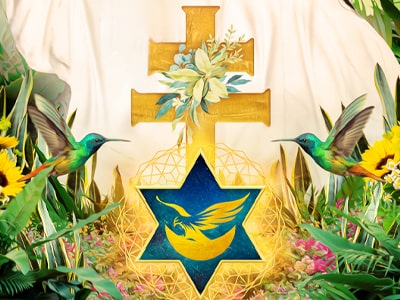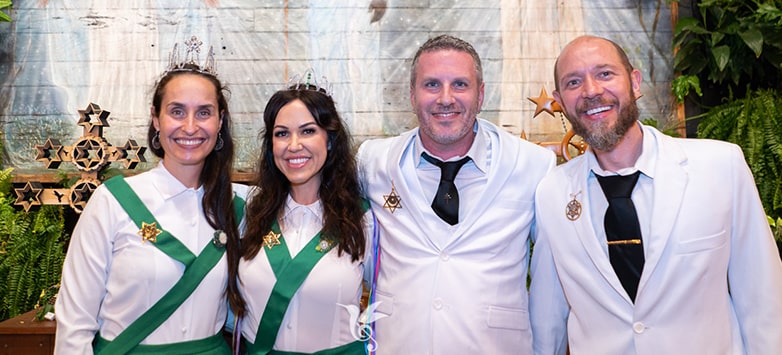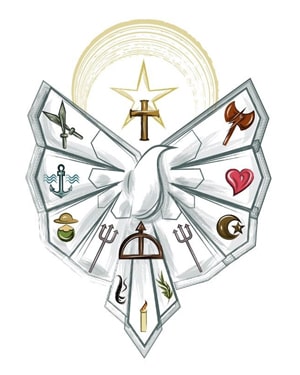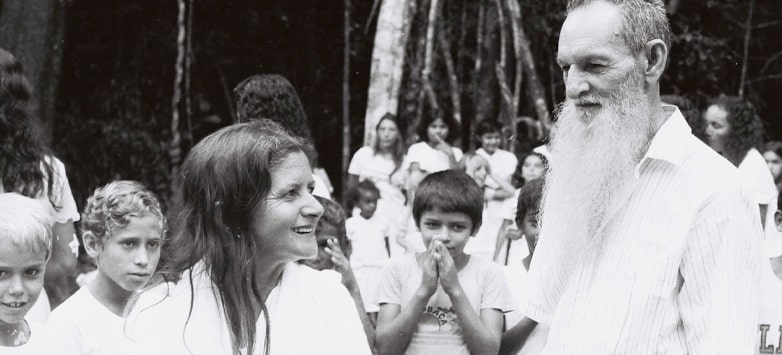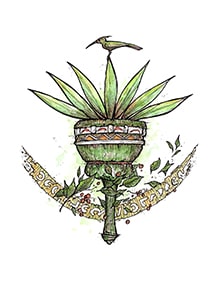Though unique in its form and practice, Umbandaime is a fusion between two Brazilian born religions. Santo Daime and Umbanda. This synthesis forms a unique combination of religious and spiritual ceremonies that revolve around using Ayahuasca, or Daime, as its foundational sacrament, allowing for a direct connection between the terrestrial and the celestial, the earth and the heavens. Both Santo Daime and Umbanda are syncretic religions that draw upon different religions, such as Kardecist Spiritism, African Animism, Catholicism, Esoteric Judaism, indigenous Brazilian shamanism, and others.
To truly understand the essence of Umbandaime, we need to have a direct experience of Ayahuasca within sacred ceremony, in paraphrasing the words of St. Thomas Aquinas:
to those who have drunk of the sacrament, no explanation is necessary;
to those who did not, no explanation will suffice.
However, we can have a theoretical glimpse into the different components that comprise the theological structure of this religion.
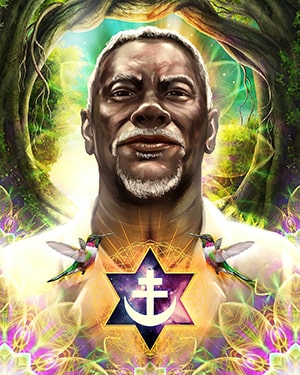
Santo Daime
Santo Daime was born through the direct and mystical experience of Mestre Irineu Raimundo Serra in the 1930s in the state of Acre, Brazil. After drinking the sacrament of Ayahuasca for a duration of eight days, Mestre Irineu had a profound vision of Mother Mary in the form of the ‘The Queen of the Forest,’ who instructed him to start the Santo Daime religion. Mestre Irineu, illiterate at the time, asked the Queen - 'But how? I do not know to read and write?' to which the Queen replied – 'Open your mouth and sing...!'
This mystical experience led to the first channeled or received hymn, 'Lua Branca' or White Moon, and the ceremonies that followed where it was sung. Today, the doctrine of Santo Daime has thousands of hymns received by its leaders, the Padrinhos, Madrinhas, and its members. Santo Daime is often referred to as a musical doctrine, teaching not only by the context and content of the hymns but through the music and melodies themselves. These hymns are divinated, and channeled through as a means to guide, instruct and direct. Often, when singing in the ceremony, one feels as if the hymn is directed at them at this exact moment in time. An answer to their intention and prayer. The hymns awaken, heal, and inspire and are considered to be the core of the Santo Daime religion.
Since its inception, Santo Daime has been characterized by syncretism and the sharing of theological concepts with other spiritual traditions and beliefs. Recognizing the inherent essence of faith and devotion that is brought to life while partaking in Ayahuasca as a sacrament. Just like the brew itself, which is a mixture of two different plants – the vine, Jagube, and the leaf, Chacruna, Ayahuasca herself indicates to the fusion of devotional practices.
The doctrine of Santo Daime, explores and navigates the map of the astral, bringing Kardecist Spiritism to its foundational understanding of the realms of spirit. Spiritism is one of the connective roots to the Umbanda religion which will be discussed later. It is important to mention the importance of the Spiritist doctrine here as a direct explanation and guide to the understanding of the Santo Daime ritual and methodology.
Santo Daime teaches and explores the realms of mediumship – the relationship between the invoked spirits and the practicing medium who discovers this innate connection when ingesting the sacrament. Navigating mediumship and understanding its core practice is widely explained in the Spiritist doctrine and is one of the main reasons that it has been integrated into the Santo Daime ritual.
---
Mestre Raimundo Irineu Serra, a black man born to a family of slaves on December 15th, 1890, in Maranhão, Brazil, lived a life of purpose and meaning, following the guidance of the Queen of the Forest, and founding her religion – Santo Daime. Mestre had to confront so many challenges and had his faith tested over and over. For many years, Mestre and his doctrine faced prejudice and persecution, but with persistence and faith, he has fulfilled his Divine Mission in bringing the Daime to the world. Santo Daime received its legal status in Brazil in 1986 and later in the United States in January of 2009.
Mestre Irineu is one of the core inspirational guides to the Church of the Celestial Heart. His faith and dedication to the Queen of the Forest is one of our guiding lights. His spirit has been with us since the church's inception. His ideals, aspirations, and teachings of love and service are found at the core of our own doctrine and teachings.
The Church of the Celestial Heart considers Fraternidade do Coração, which is a universalist Daime church based in São Paulo, Brazil, led by Padrinho Sergio Negri, to be our mother church and our source of inspiration. Both Padrinho Karrel and Madrinha Osborne have received their official ‘Fardamento’ and stars from this church and are proud to represent and belong to this incredible source of inspiration and teachings of devotion and awakening.
Umbanda
Though there are a few different histories related to the birth of Umbanda in Brazil, the most common and agreed upon in most Umbanda houses, or Terreiros, is related to Zélio Fernandino de Moraes, founding the official line of Umbanda on November 15th, 1908, as instructed by a channeled spirit - Caboclo das Sete Encruzilhadas, who appeared and incorporated into young Zélio (who was 17 at the time) at a Kardecist Spiritist house. The Caboclo and other spirits who came to other mediums present were not accepted and were asked to leave. As a response, Zélio announced that the following day, a new religion would be born and a place for these discarnate spirits to come and do their work. And so it was. The first center of Umbanda was formed – ‘Tenda Espírita Nossa Senhora da Piedade.’ Leading the path for Umbanda to be birthed and practiced in Brazil.
Today, Umbanda is practiced all over Brazil and has hundreds of thousands of practitioners and hundreds of houses of worship. Umbanda, at its core, is a mediumistic house of worship and devotion, guiding its devotees to interact with the realms of spirit and offer charity, healing, and spiritual guidance. It is rooted in African Animism, which relates to the personification of the forces of nature, or Orishas. In difference to Candomblé or IFA, Umbanda primarily calls upon the discarnate spirits, and entities who were once human and can relate to the human experience. Umbanda recognizes the map left by the Kardecist Spiritism and brings about another layer to its doctrine, the incorporation and embodiment of spirit. Umbanda is monotheistic, believing in the existence of one creator or source of Divinity, named Ọlọrun or Olódùmarè, which is the unnamed name for God in all forms. At its core, Umbanda, similar to many African-based religions, recognizes the Orishas as the personified intermediaries of God. Categorized into seven lines, or realms, which archetypically explain the nature of the universe. The spirits that come through the process of mediumship relate to the Orishas and come to offer their guidance and profound teachings.
Similar to Santo Daime, Umbanda is syncretic and incorporates different religions and spiritual traditions into its theology. It has no official central institutional authority, which has allowed the extensive development of its growth and the individualized presentation of its ideals by the different houses that practice its tenets.
Umbanda, to me, is a poetic form of religion that brings about a profound shift in our connection to life itself. It is the practice of the Art of Devotion. Each ritual, initiation, or rite of passage is an artistic expression of a devoted heart. The ritualistic form, in practice, involves all senses and is experienced in many ways - dance, taste, smell, color, movement, prayer, and stillness. Umbanda is a language used to describe the unseen realms of spirit. Calling, invoking, and dancing the spirits here into the material form, using our human body and our human spirit as a bridge to the astral. Umbanda draws a map, depicting and personifying the forces of nature, as guidance for us to connect and understand our own truest and most essential nature, helping us navigate the complexity of our human experience.
The Orishas, deities, Gods, and Goddesses tell a mysterious tale of cosmic evolution. A story of epic proportion that is being played through us, by us, for us and within us to this very moment. This mythical story, as it unravels in its form and expression, allows for a profound sense of connection and purpose, giving our lives meaning and direction. It is a form of religious animism, which means it innately relates to the elements and expressions of Mother Nature and its timeless guidance for the evolution of spirit. It is an endless story of the terrestrial and its connection to the spiritual realms of the astral. Allowing the discarnate spirits that incorporate or come to be embodied through the process of mediumship to enact this cosmic tale and have it told through the human spirit and for the evolution of humanity.
Umbandaime
And here, we find the connection to the Daime, or Ayahuasca, considered by many to be the essence of the blood and water of Mother Earth. A divinated sacrament that acts as a direct bridge between the plant kingdom, the human kingdom, and the astral planes. When received in the sacred setting of a holy ritual, Ayahuasca brings us to this exact same realm of connection, allowing the nature of nature to connect us, awaken our spirit, and, just like Umbanda, help us express divinity and devotion as a form of religious devotional art.
The word religion in its Latin and most ancient form is Religare – Re-Ligare or Re-Connect. A term used to describe a spiritual or even mystical phenomenon. One that truly can only be described by direct and personal experience. Reading and understanding the molecular structure of water does not have the same experience or impact as bathing in the ocean for the first time. Umbandaime, therefore, is the direct link between the experience of divinity and the grounding of these astral teachings, here in the material, through the plant kingdom and alchemy of a human heart.
The Daime, Ayahuasca, comes to us from the depth of the Amazonian jungle; it is not a surprise that these traditions have flourished so vastly in Brazil, where nature is so abundant, and its voice cannot be forgotten. The jungle beckons us to remember, the rivers teach us to forgive, and the mountains call for us to rise and elevate.
Here, in the heart of the Amazonian jungle, Santo Daime was born, following the guidance of the Queen of the Forest herself. Mestre Irineu followed the calling of nature, the same calling of the Caboclos and Orishas of Umbanda, the return to nature, and the willingness to listen to the voice of Mother Earth. Divinated as Ayahuasca, a holy sacrament coming to awaken her children and bring them back to reconnect, remember, heal, and awaken.

Mãe Baixinha
It is not possible to write about Umbandaime without mentioning Divina Baixinha, who we in the Church of the Celestial Heart consider to be our spiritual mother. Baixinha, who is lovingly called the Little Giant, was a Mãe de Santo (Priestess) of Umbanda who, in following the instruction of her guide, Caboclo Tupinamba, traveled to meet with Padrinho Sebastião, the residing founder of Santo Daime in Mapia. The Caboclo instructed Baixinha to drink the Daime, something that, as a practitioner of Umbanda, she did not do, as it is not a part of her religion and practice. In that historic ceremony, Umbandaime was born. The Caboclo from Umbanda, drinking the Daime of the Astral, thus creating this Divine Union of these two lines. Mãe Baixinha received the Padrinho’s blessing to bring the Daime into the Umbanda Giras, and thus started the work of unification that continues to this very day.
In one of the first ceremonies I attended in Brazil, in the early days of walking this path with Ayahuasca, before I ever heard of Santo Daime, Umbanda, or mediumship, I received a message in ceremony, “Go to Baixinha.” Go to… so I assumed Baixinha was a place. When I asked my teacher where Baixinha is, he explained that Baixinha is not a place… it is a person, an Umbandaime Mãe de Santo, living in the nearby city of Lumiar. Though I never got to meet Baixinha in person while she was alive, that message has led to the discovery of Santo Daime, Umbandaime, and a few years later to a direct connection with Caboclo Tupinamba and other spirits who are now guiding our mission and our church. So many miraculous stories and “coincidences” have transpired over the years in relation to both Baixinha and Caboclo Tupinamba; one of the most magical ones relates to how the Starred members of our church got to receive the same Blue Star worn by Baixinha and so many of the magical teachings that came around it. Mãe Baixinha is always loved and honored within our church and forever shall be our guiding light.
All the Children of Earth have the right to deserve:
Life, Health, Happiness, Open Paths!
Health in the Body, Peace in the Spirit, and Love in the Heart!
~ Caboclo Tupinamba
Further Reading and Study
- Nossa Irmandade - About the Doctrine of Santo Daime (in English)
- Official website of Santo Daime (in Portuguese)
- Chacruna.net - About Mestre Irineu (in English)
- About Mestre Irineu (in Portuguese)
- About Zélio Fernandino de Moraes
- Books of Tilo de Àjàgùnnà, especially The Sacred Umbanda.
- Religious Studies about Umbandaime by G. William Barnard (in English)
- Official Website of Flor Da Montanha - Mãe Baixinha (in Portuguese)
- Short movie about Flor Da Montanha and Umbandaime (in Portuguese)
